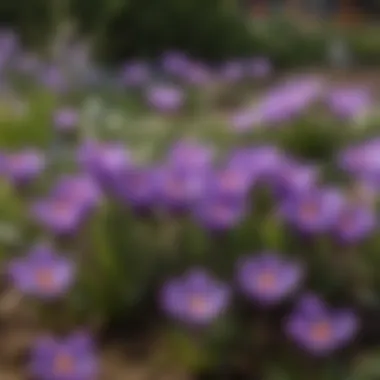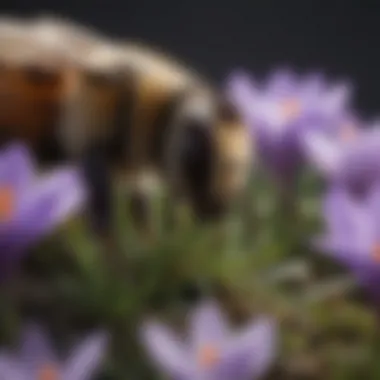Understanding Purple Crocus Bulbs: A Comprehensive Guide


Intro
Purple crocus bulbs have captivated gardeners and nature enthusiasts for generations. Their delicate blooms herald the arrival of spring, bringing vibrant color to gardens after the long winter months. Understanding these bulbs involves exploring their biology, cultivation requirements, and the ecological benefits they offer. This guide aims to inform enthusiasts, educators, and families about the various aspects of purple crocus bulbs, from planting to their role in promoting biodiversity.
Overview of Purple Crocus Bulbs
Common Name and Scientific Classification
The common name for these flowers is the purple crocus. Scientifically, they belong to the genus Crocus, which falls under the family Iridaceae. The most recognized species in this category is Crocus vernus, known for its striking purple hue. This flowering plant is native to Europe and parts of Asia, showcasing the adaptability of these bulbs across different environments.
Physical Characteristics
Purple crocus bulbs are notable for their cup-shaped flowers, which bloom in shades ranging from deep violet to lighter purple. The leaves are narrow and appear in clusters, typically growing from the base of the plant. Each bulb can produce several flowers, creating a stunning display when in bloom. The flowers usually open during the day and close at night, responding to sunlight.
Habitat and Distribution
These bulbs thrive in well-drained soil and prefer sunny locations. In the wild, they can often be found in meadows, woodlands, and rocky slopes. When cultivated, they are often planted in gardens, parks, and other landscaped areas, enhancing both aesthetic appeal and ecological diversity. Their adaptability has allowed them to spread to various regions beyond their native habitats, including areas of North America.
Importance in Ecology
Purple crocus bulbs are not just ornamental plants. They play a significant role in their ecosystems. These flowers provide crucial early-season nectar for pollinators such as bees and butterflies. The blooms emerge at a time when few other plants are flowering, thus serving as a vital food source for these insects.
"Crocus bulbs, especially purple varieties, are critical for supporting local pollinator populations in early spring."
In addition to supporting pollinators, they contribute to soil health. Their root systems help aerate soil, improving its structure and promoting healthier plant growth in surrounding areas. Gardeners who include purple crocus bulbs in their landscape not only enhance visual appeal but also foster a more resilient ecosystem.
Cultivation Tips
Planting purple crocus bulbs can be a rewarding experience. Here are some key points to consider:
- Soil: Ensure well-draining soil to prevent bulb rot.
- Location: Choose a sunny spot for optimal growth.
- Planting Depth: Plant bulbs about 3 to 4 inches deep.
- Watering: Water moderately, allowing soil to dry slightly between waterings.
By understanding the needs of purple crocus bulbs and recognizing their ecological importance, readers will find that these flowers offer more than just beauty in their gardens.
Prolusion to Purple Crocus Bulbs
Purple crocus bulbs hold significant value not only for aesthetic appeal but also for their ecological contributions. This section introduces the reader to the essential elements of these bulbs, providing a fundamental understanding of their characteristics and benefits.
Overview of Crocus Species
Crocus belongs to the Iridaceae family, with a wide variety of species that bloom in early spring. Among these, the purple-crowned varieties often stand out. The most common ones include Crocus vernus, commonly known as the spring crocus, and Crocus tommasinianus, known as the snow crocus. Each species possesses unique traits that contribute to their garden performance.
These species are characterized by their cup-shaped flowers that emerge from underground corms. Typically, the purple shades range from deep violet to pale lilac, creating a vibrant display when planted in clusters. The ability to thrive in diverse environments makes them suitable for a variety of gardeners, from amateurs to enthusiasts. They do well in well-drained soil and prefer sunny locations, which underscores their adaptability.
Importance of Purple Varieties
Purple crocus varieties are more than just visually appealing. They play a crucial role in the ecosystem. These flowers are early bloomers, often heralding the arrival of spring. They provide an important food source for pollinators such as bees after a long, harsh winter. As the flowers are among the first to open, they contribute to the health and stability of local ecosystems.
Additionally, the cultural significance of purple crocus cannot be overlooked. In various cultures, these flowers symbolize renewal and the promise of warmer weather. Their presence in gardens not only enhances visual beauty but also promotes biodiversity.
"Purple crocus bulbs not only beautify landscapes but also support ecological balance by aiding early spring pollinators."
Biological Characteristics


Understanding the biological characteristics of purple crocus bulbs is essential for successful cultivation and appreciation of their role in ecosystems. The morphology and growth cycle of these plants offer insights into how they adapt and thrive in various environments. Awareness of these characteristics benefits gardeners and environmentalists alike, assisting them in fostering biodiversity and maintaining healthy gardens.
Morphology
Petal Structure
The petal structure of purple crocus bulbs is a notable aspect that contributes to their visual appeal and functionality. The petals are typically elongated and exhibit a vibrant purple hue, which is not only stunning but also plays a critical role in attracting pollinators. The delicate texture enhances light reflection, making them noticeable in garden settings.
One key characteristic of petal structure is its ability to endure varying weather conditions. Purple crocus petals are resilient against early spring frosts, which allows them to bloom earlier than many other flowers. This trait makes them a popular choice among gardeners looking for early spring blooms.
However, despite their advantages, the petals can be relatively fragile. Intense rain or wind may damage them, which is a consideration for those in harsher climates. Adopting protective measures, such as strategic planting or providing temporary windbreaks, can mitigate this issue.
Leaf Arrangement
Leaf arrangement of purple crocus is another important aspect. The leaves typically emerge from the base of the plant, in a linear configuration. This arrangement allows efficient sunlight capture, essential for photosynthesis during the growing season.
A significant characteristic of leaf arrangement is its ability to vary based on environmental conditions. In optimal settings, the leaves can grow robust and healthy, aiding in nutrient absorption. This adaptability makes purple crocus an excellent choice for diverse garden designs.
However, crowded planting may lead to competition among leaves for sunlight, potentially stunting growth. Gardeners must be mindful of spacing to ensure each plant receives adequate light for optimal health.
Growth Cycle
Dormancy
Dormancy in purple crocus bulbs serves as a crucial phase in their growth cycle. It typically occurs in the warmer months after the blooming period. During dormancy, the plant conserves energy and resources, preparing for the next cycle of growth. Understanding dormancy is important because it influences planting times and care methods.
A key characteristic of dormancy is the bulb's ability to withstand periods without active growth. This resilience allows these bulbs to thrive in diverse climates and conditions. For gardeners, knowing when dormancy occurs helps in scheduling their bulb care, such as watering and fertilization.
However, if the conditions are too wet or too dry, it could affect the health and longevity of the bulb. It's essential for caretakers to monitor soil moisture and conditions, adjusting as necessary to keep bulbs healthy during this crucial stage.
Shooting
The shooting phase is when the purple crocus begins to emerge from dormancy. This marks the transition from energy conservation to active growth. Typically, shooting occurs in late winter or early spring, coinciding with warming soil temperatures.
A notable characteristic of this phase is the rapid growth of the shoots, which can break through frozen ground. This adaptability means that they can capitalize on early warmth in their environment. The benefit of this phase is that it allows purple crocus bulbs to take advantage of early-season pollinators, thus enhancing their reproduction potential.
However, shooting can be affected by late frosts that may damage tender emerging shoots. Protection strategies, such as mulch or coverings during unpredictable weather, are beneficial.
Blooming
Blooming is the most celebrated phase of the purple crocus growth cycle. It signifies the culmination of the plant's life stages, displaying vibrant flowers that attract many pollinators. This period usually lasts several weeks, offering a spectacular view in gardens.
The distinct characteristic of blooming is its timing; many purple crocus varieties bloom well before other spring plants. This characteristic not only adds beauty to the landscape but also ensures that early pollinators have accessible food sources.
While blooming is a highlight, gardeners should be aware that the visual spectacle is brief. After blooming, the plant begins to prepare for dormancy again. Planting additional flowering plants can enhance the garden's aesthetics over time, ensuring continuity in blooms even after the crocus has finished its cycle.
Cultivation Techniques
Cultivation techniques are essential when it comes to growing purple crocus bulbs. These techniques not only influence the health and vibrancy of the plants but also ensure their successful integration into various garden environments. Understanding the right practices can lead to a thriving display of these beautiful flowers, providing both aesthetic joy and ecological benefits.
Selecting Quality Bulbs
Selecting quality bulbs is a decisive step in the cultivation process. High-quality bulbs are typically plump, firm, and free from any signs of disease or damage. Choosing healthy bulbs minimizes the risk of pests and diseases that could affect growth. Look for bulbs with a strong color. This indicates vigor. It is a common mistake to purchase bulbs that are soft or shriveled. Always inspect the bulbs thoroughly before purchasing, as this can greatly impact the outcome.
Soil and Site Preparation


Preparing the right soil and site conditions is crucial for the successful growth of purple crocus bulbs. These plants prefer well-draining soil enriched with organic matter. The location should receive full sun, which is vital for their blooming phase.
- Soil Type: Ensure the soil is loamy and loose. Compacted soil can hinder root development.
- pH Level: Check for a neutral to slightly acidic pH. This can often be adjusted with amendments such as sulfur or lime, if necessary.
Additionally, proper site preparation can prevent water from pooling, which could lead to rot. Therefore, testing and amending the soil before planting can set a strong foundation for growth.
Planting Guidelines
Optimal Depth
Optimal depth is a significant factor when planting purple crocus bulbs. Generally, bulbs should be planted at a depth of about three to four inches. This depth provides warmth, supports root establishment, and protects the bulbs from winter frost. When planted too shallow, the bulbs may emerge prematurely, making them vulnerable to late frosts. Conversely, deeper planting can impede shoot growth.
Having depth considered is widely seen as a beneficial approach, promoting healthy and vibrant blooms.
Spacing Considerations
Spacing considerations play an important role in the cultivation of purple crocus bulbs. It is advisable to space them about three to six inches apart. This spacing allows for adequate air circulation and reduces competition for nutrients. If spaced too closely, bulbs may struggle, leading to smaller blooms or even failure to flower.
Proper spacing is a popular strategy for enhancing aesthetic appeal in garden layouts. Each bulb has room to grow, allowing its full potential to be realized.
Watering Requirements
Watering requirements for purple crocus bulbs are quite straightforward. These bulbs require moderate moisture, especially during their growth period. Over-watering can lead to bulb rot, while under-watering can result in poor growth and diminished bloom quality. After planting, it is important to keep the soil lightly moist during the growing season. Once the foliage dies back, reduce watering to prevent issues.
Fertilization Practices
Fertilization practices enhance bulb performance. Using a balanced fertilizer high in phosphorus can support strong root development. A general-purpose fertilizer applied at planting, and later in the growing season, can provide the necessary nutrients. However, care must be taken to avoid over-fertilization, which can burn the bulbs and affect bloom quality. It is often recommended to test soil fertility prior to applying fertilizers to tailor the approach specifically to the soil’s needs.
Maintaining careful attention to these cultivation techniques sets the stage for robust growth and beautiful displays of purple crocus, enriching gardens and ecosystems alike.
Pest and Disease Management
Managing pests and diseases is crucial for maintaining the health and vitality of purple crocus bulbs. These bulbs, while hardy, are not immune to various threats that can hinder their growth and aesthetic appeal. Effective pest and disease management strategies can ensure robust flowering and contribute positively to the garden ecosystem. When mismanaged, the health of the plants can decline, leading to poor growth, reduced flowering, and potentially the death of the bulbs. Therefore, understanding common threats and preventive measures is essential for any gardener.
Common Pests
Purple crocus bulbs can be susceptible to a range of pests that may damage the plant or, in some cases, the bulbs themselves. Understanding these pests is the first step in effective management.
- Bulb Nematodes: These microscopic worms can invade bulbs, causing rot and potentially leading to the death of the plant. Symptoms include yellowing leaves and stunted growth.
- Flower Thrips: These small insects feed on plant tissues, typically causing distortions in flowers and leaves. They can be difficult to spot due to their size but may leave visible signs.
- Aphids: Common garden pests that feed on the sap of plants. They can transmit viruses and weaken plants. Aphids typically colonize the stems and undersides of leaves.
Controlling these pests involves a combination of monitoring and intervention. Regular checks for visible signs of infestation can lead to timely action, such as removing affected plants or applying suitable insecticides.
Disease Prevention
Preventing diseases is an integral part of crocus bulb management. Several practices can minimize the risk of diseases affecting the bulbs.
- Proper Planting Depth: Planting purple crocus bulbs at the correct depth can enhance drainage and reduce the risk of rot. Typically, planting 3-4 times the bulb's height is sufficient.
- Good Drainage: Ensure the soil has excellent drainage capabilities. Overly damp conditions can encourage fungal infections, which are particularly harmful to bulbs.
- Sanitation Practices: Clean tools and remove debris from the planting area to eliminate potential sources of disease.
Effective disease prevention is always easier than dealing with established infections. Prioritize preventive measures in your gardening routine.
By being proactive and attentive to the specific needs of purple crocus bulbs, gardeners can create a hospitable environment, free from pests and diseases. Such awareness not only enhances the beauty of the garden but promotes a healthier ecosystem for pollinators and other beneficial wildlife.
Ecological Contributions
Purple crocus bulbs play an important role in the ecosystem, exhibiting benefits that go beyond their visual appeal. Understanding their contributions can enhance gardening practices while promoting environmental sustainability. The cultivation of these bulbs not only beautifies gardens but also serves as an essential component in fostering a healthy ecosystem.


Supporting Pollinators
One of the key ecological benefits of purple crocus bulbs is their ability to support pollinators. These bulbs bloom in early spring, providing blooms that are among the first available after winter. This is crucial for various pollinators, including bees, which are emerging from hibernation and are in need of food sources.
The nectar and pollen from purple crocus flowers attract a variety of species. Research has shown that early-flowering plants like crocuses can significantly supplement the diet of honeybees and solitary bees early in the season.
The following points are worth considering when looking at the relationship between purple crocus and pollinators:
- Timing of Bloom: The early spring timing allows these plants to capitalize on a period when few other food resources are available.
- Pollinator Diversity: The ability of crocuses to attract a wide range of pollinators can help maintain biodiversity.
- Nectar Quality: The quality of nectar in purple crocus may influence pollinator preferences, with opportunities for research into its chemistry.
By planting purple crocus bulbs, gardeners can contribute to the stabilization of pollinator populations.
Biodiversity in Gardens
Incorporating purple crocus bulbs into garden landscapes promotes biodiversity, which is essential for ecosystem health. Biodiversity refers to the variety of plant and animal life present, which contributes to resilience against diseases and environmental changes.
Here are aspects to consider regarding purple crocus and biodiversity:
- Habitat Creation: Gardens with diverse plant species can provide various habitats for insects, birds, and other wildlife.
- Soil Health: Diverse planting can improve soil structure and health, making environments livelier.
- Food Web Support: By attracting not just pollinators but also other beneficial insects, the presence of crocuses supports intricate food webs within garden ecosystems.
In summary, the ecological contributions of purple crocus bulbs are significant. Their role in supporting early spring pollinators and promoting biodiversity cannot be overstated. Gardeners who choose to grow these bulbs do not just enhance their aesthetic appeal, rather they actively engage in fostering a more sustainable environment.
Cultural Significance
The cultural significance of purple crocus bulbs goes beyond their visual appeal. They have held meaning in various societies and traditions throughout history. Their presence in gardens and public spaces often serves as a connection to both heritage and nature. In understanding this cultural dimension, one can appreciate the rich tapestry of life that crocus contributes to human experiences.
Symbolism in Art and Literature
Purple crocus has been referenced in multiple artistic and literary works, symbolizing renewal, spring, and hope. In poetry, the blooms often signify the arrival of warmer seasons and the end of winter's harshness. Many artists have used purple crocus to depict the durability of life against challenging conditions. This theme not only resonates with horticulturalists but also with anyone who seeks inspiration from nature.
Often, these flowers are depicted alongside other elements of nature, reinforcing their role as harbingers of joy and beauty. For example, several poems from the Romantic period highlight how these flowers lift spirits and invoke a sense of wonder. The purple hue itself is associated with nobility, emphasizing a flower's revered status in various cultures.
Local Festivals and Traditions
Celebrations around purple crocus bulbs can be seen in different locations worldwide. These festivals frequently highlight the transitional seasons and foster community spirit. Local events often include planting ceremonies, flower shows, and educational workshops focused on the significance of these bulbs.
- Crocus Festival: In some regions, festivals celebrate the blooming of crocus with art displays and floral arrangements, encouraging local gardeners to showcase their skills.
- Harvest Celebrations: Certain agricultural societies have festivals during the blooming season where people come together to appreciate nature's beauty and discuss gardening techniques.
Such events not only bring joy to communities but also emphasize the importance of biodiversity and environmental health. Encouraging the awareness of purple crocus bulbs fosters a deeper understanding of their role in gardening and the loss of habitat. The overall significance of these traditions illustrates how nature provides opportunities for people to bond and learn together.
Understanding the cultural significance of purple crocus bulbs can inspire deeper respect for the environment and its many gifts. It highlights the relationship between human celebrations and nature's cycles.
Ending
The conclusion of this article encapsulates the significance of purple crocus bulbs, emphasizing the various aspects of their cultivation and ecological importance. Understanding these bulbs is not just about their visual appeal but also about recognizing the benefits they bring to both gardens and local ecosystems.
Summary of Key Points
In the exploration of purple crocus bulbs, several key points emerge:
- Diversity of Species: There are multiple varieties of purple crocus, each with distinct growth habits and environmental needs. Understanding these can help in selecting the right type for a specific garden.
- Cultivation Techniques: Proper planting techniques, soil preparation, and watering practices are crucial for successful growth. Knowledge of these techniques ensures that the bulbs thrive and provide abundant blooms.
- Pest and Disease Management: Awareness of common pests and diseases helps in keeping the plants healthy. Implementing preventive methods can save time and effort in maintaining the garden.
- Ecological Contributions: Purple crocus play a vital role in supporting local biodiversity. They attract pollinators such as bees, which are essential for many other plants.
- Cultural Significance: These bulbs also hold cultural value, symbolizing various meanings in art and festivals around the world.
Encouragement for Cultivation
Cultivating purple crocus bulbs offers not only aesthetic pleasure but also contributes to ecological balance. For those considering planting these bulbs, here are a few considerations:
- Start Small: Beginners may start with a few bulbs to understand their growth requirements without feeling overwhelmed.
- Educate Others: Share knowledge about these bulbs with friends, families, or community groups. Planting together can foster a sense of community and appreciation for nature.
- Experiment: Trying different varieties or planting designs can lead to discovering unique combinations that thrive in a particular environment.
- Be Observant: Monitoring the growth and health of the bulbs can provide insights into the best care practices, fostering a deeper understanding of horticulture.
Embracing the beauty of purple crocus bulbs allows anyone to play a part in sustaining our environment, enhancing both personal spaces and natural ecosystems.
In essence, cultivating purple crocus is worthwhile, adding both beauty and ecological benefits to any garden. This guide serves as a starting point for interested individuals to begin their journey with these remarkable bulbs.







